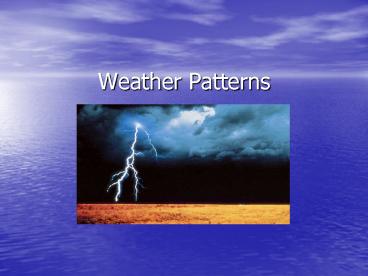Weather Patterns PowerPoint PPT Presentation
1 / 11
Title: Weather Patterns
1
Weather Patterns
2
Air Masses
- A huge body of air that has similar temperature,
humidity, and air pressure throughout it is
called an air mass. - A single air mass may spread over an area of
millions of square kilometers and be up to 10
kilometers high.
3
Types of air masses
- Tropical, or warm, air masses form in the tropics
and have low air pressure. - Polar, or cold, air masses form north of 50
north latitude and south of 50 south latitude. - Polar air masses have high air pressure. WHY?
Cold Air is more dense - Maritime air masses form over oceans. Water
evaporates from the oceans, so the air can become
very humid. - Continental air masses form over land, in the
middle of continents, and are dry.
4
Types of Air Masses
- Four major types of air masses influence the
weather - in North America maritime tropical, continental
- tropical, maritime polar, and continental polar.
- Maritime Tropical Warm, humid air masses form
over oceans near the tropics. - Maritime Polar Cool, humid air masses form over
the icy cold North Pacific and North Atlantic
oceans. - Continental Tropical Hot, dry air masses form
only in summer over dry areas of the Southwest
and northern Mexico. - Continental Polar Large continental polar air
masses form over central and northern Canada and
Alaska. As you would expect, continental polar
air masses bring cool or cold air.
5
Fronts
- The area where the air masses meet and do not mix
becomes a front. - The term front, which is borrowed from military
language, means a battle area where opposing
armies meet to fight. When air masses meet at a
front, the collision often causes storms and
changeable weather. - There are four types of fronts cold fronts, warm
fronts, stationary fronts, and occluded fronts.
6
Cold Front
- When a rapidly moving cold air mass runs into a
slowly moving warm air mass, the denser cold air
slides under the lighter warm air. The warm air
is pushed upward. The front that forms is called
a cold front. - Cold fronts move quickly, so they can cause
abrupt weather changes, including violent
thunderstorms. - After a cold front passes through an area, cool,
dry air moves in, often bringing clear skies and
cooler temperatures
7
Warm Fronts
- Warm Fronts Clouds, storms, and rain also
accompany warm fronts. - At a warm front, a moving warm air mass collides
with a slowly moving cold air mass. Because cold
air is more dense than warm air, the warm air
moves over the cold air. - Because warm fronts move more slowly than cold
fronts, the weather may be rainy or foggy for
several days. - After a warm front passes through an area, the
weather is likely to be warm and humid. In
winter, warm fronts bring snow.
8
Stationary Fronts
- Stationary Fronts Sometimes cold and warm air
masses meet, but neither one has enough force to
move the other. In this case, the front is called
a stationary front. - If a stationary front remains stalled over an
area, it may bring many days of clouds and
precipitation.
9
Occluded Front
- In an occluded front, a warm air mass is caught
between two cooler air masses. The denser cool
air masses move underneath the less dense warm
air mass and push it upward. - The two cooler air masses meet in the middle and
may mix. The temperature near the ground becomes
cooler. - As the warm air cools and its water vapor
condenses, the weather may turn cloudy and rainy
or snowy.
10
Cyclones
- The L is short for low, and indicates an area
of relatively low air pressure. A swirling center
of low air pressure is called a cyclone. - As warm air at the center of a cyclone rises, the
air pressure decreases. Cooler air blows toward
this low-pressure area from nearby areas where
the air pressure is higher. - Cyclones play a large part in the weather of the
United States. As air rises in a cyclone, the air
cools, forming clouds and precipitation.
11
Anticyclones
- Anticyclones are high-pressure centers of dry
air. Anticyclones are also called highsH on a
weather map. - Winds spiral outward from the center of an
anticyclone, moving toward areas of lower
pressure. - The descending air in an anticyclone causes dry,
clear weather.

